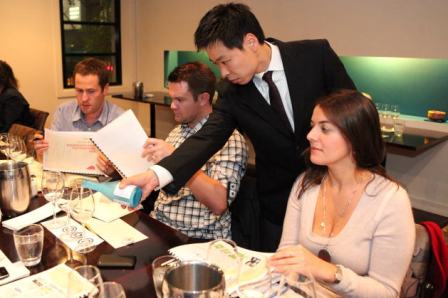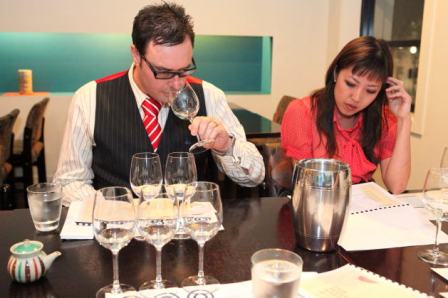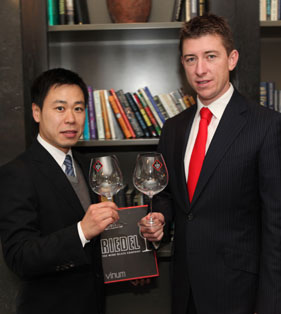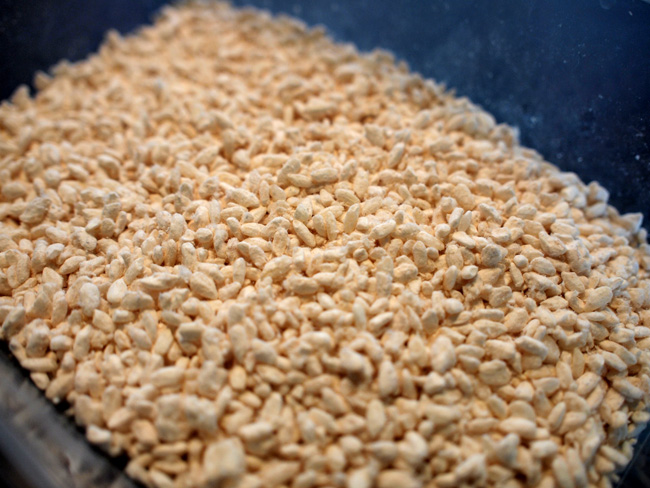Japanese
Learn the essence of “sake” from a sommelier.
What does “sake” mean to Mr.Masahiko Iga, the famous sommelier?
A “sake” tasting sponsored by Sommeliers Australia was held at “Hanabishi” restaurant, on Tuesday, May 4th,with Mr .Masahiko Iga, the distinguished Sake sommelier of the association, serving various kinds of “sake”. The number of participants was limited to 14.
The “sake” served at the tasting were mostly collected by Mr. Iga in Japan.

The man in the middle is Mr. Dan Sims, the Victoria National Executive of Sommelier Australia Association; the man next to him is Mr. Chris Crawford, the sommelier of the restaurant Circa the Prince.
The bottles of “sake” chosen were all rare ones that are seldom found even in liquor shops in Japan. Mr. Iga went back to Japan and personally visiting his favorite “sake” makers and collected them for this occasion.

The man on the left is a business man who runs a number of Japanese restaurants in Melbourne. He is very fond of “sake”.
Because he is a sommelier, or a wine specialist, it does not mean that he has no interest in other kinds of liquor. The Australian sommeliers are rather eager to learn to enjoy anything new. Consequently, they have a surprisingly profound knowledge of “sake”. They tried a series of “sake”, studying the handout prepared by Mr. Iga. They put one sharp question after another to Mr. Iga, naturally knowing such jargon as “Yamada nishiki”, “Shinpaku”, “Migaki”, and “Kouji”.

Even though there are spitoons for discarding wine left in the glass, all the participants drink all the “sake” rather than use the spitoons. This is how Australian sommeliers taste “sake”.
(Note: They usually spit out the wine they have tasted into the pail rather than swallow it. This time they don’t do this, which shows their affection for “sake”)
They empty their glasses, gulping down one glass of “sake” after another. Each has a sheet of paper at hand to jot down the details of what they find after tasting “sake”.
Conventional wine glasses are suitable for tasting and smelling “sake”. When they have a Japanese meal in a Japanese restaurant, they usually aren’t served “sake” in a wine glass. On this occasion, however, they are not there to enjoy a meal, so the “sake” tasting proceeds in whatever way the Australian sommeliers consider best.

In the middle of the picture, Mr. Ben Edwards, President of Sommeliers Australia, is holding a wine glass. On the left is Mr. David Clarke, a sommelier of Vue de monde.
After tasting several glasses of “sake”, the participants are served Japanese dishes by Mr. Iga. They are Hanabishi’s specialties carefully chosen to perfectly match the “sake” the participants are tasting.
The other day, Mr. Iga participated in the Wine Competition sponsored by a leading wine company which only professional trade people are allowed to. It was a competition in which the participants were to guess the name of the wine served with its label covered. Only five of the several hundred participants, including Mr. Iga, gave the correct answers to all the questions such as the origin,the kind, and the age of the wine, the origin of the barrel in which wine is left to age, whether or not a barrel is used, whether the barrel is new or old, and the name of the wine maker. And Mr. Iga was the only person who gave the correct answers to the questions what grade the wine was and what alcohol content it had.

The “sake” in the middle is called “Bon Chogin” which was served at the wedding reception of the Crown Prince of Japan.

Mr. Iga answers with accuracy the acute questions asked by the members. Australia is a great wine country but its history of wine is short compared to that of Europe. The production has been increased and the quality has been improved thanks to the new technology and diligence of the wine makers. “Sake” has become more and more popular recently, and as is evident from this “sake” tasting, the phenomenon is not superficial.
All the data for this “sake” tasting was provided by Mr. Iga, and is considered to be first-class and can be downloaded from “Hanabishi” restaurant’s website. http://www.hanabishi.com.au/news-events/default.aspx

Photo: Mr.Iga and Mark Baulderstone, CEO of Riedel Asia Pacific. Mr. Iga won the prize and received high-quality crystal wine glasses at the blind wine tasting competition sponsored by Riedel.



